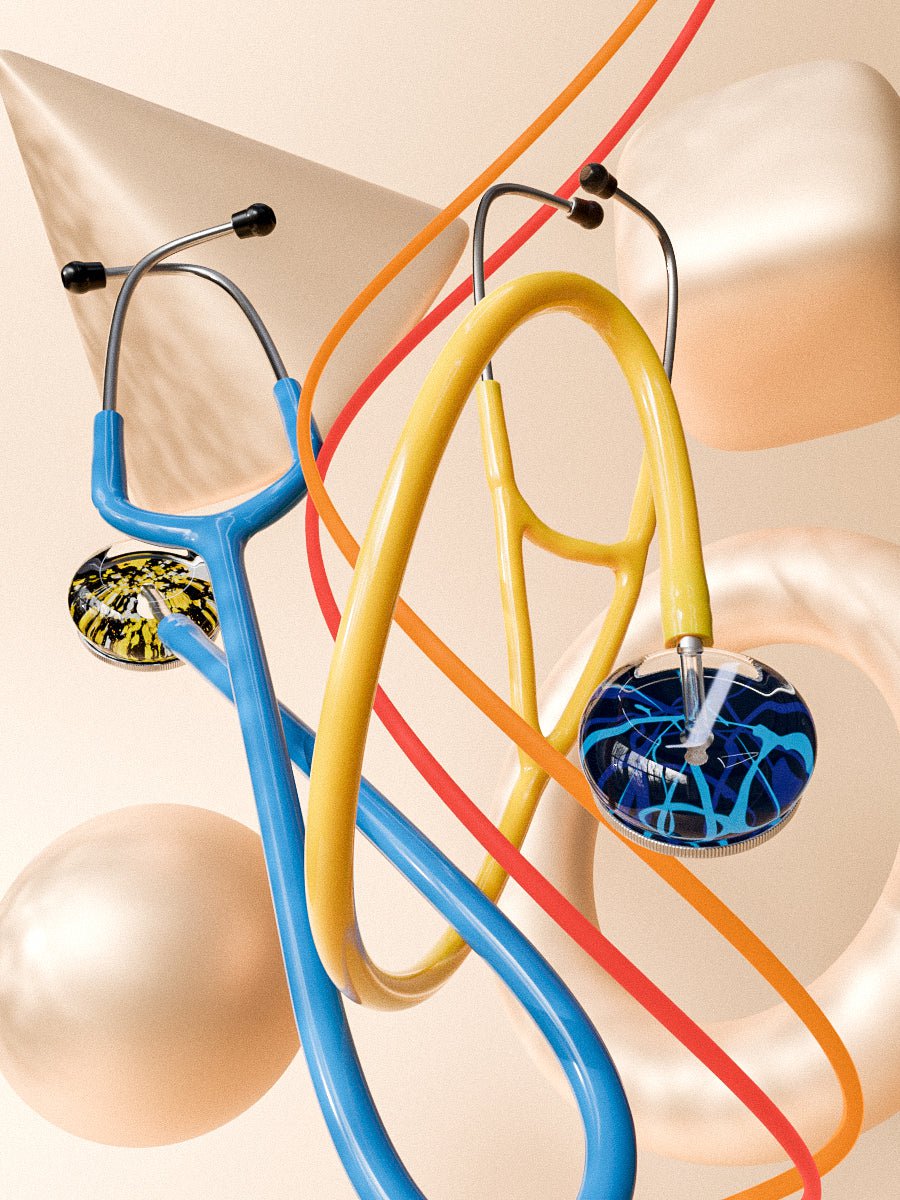Medical practitioners most of the time use stethoscopes during the examination of patients in clinics and hospitals. Stethoscopes can help detect abnormal heart rates, unusual sounds from the abdominal organs and the lungs.
The tubing material on stethoscopes is made of PVC, which normally hardens over time due to contact with lipids that are found in the human skin. Also, check out the Ultrascope glitter or bling stethoscopes.
Why does your stethoscope tubing wear out?
There are several reasons as to why this happens. Let’s have a look.
You possibly over wipe your stethoscope tubing
One of the most common reasons why the tubing on your stethoscope may be wearing out or cracking is you over wipe it using alcohol. The same way your hands may crack if you wash up too often so does your stethoscope tubing as it will become vulnerable and frail. The alcohol content in the cleaning agent slowly eats away the rubber tubing.
If you always wear your stethoscope around the neck
Wearing a stethoscope around your neck at all times may appear to be sort of a cool thing as it makes you look like a real doctor. It also makes it easy to use the stethoscope on the patient without much hassle. It may be a practical thing to always wear your stethoscope always around your neck, but it may have devastating effects on the tubing.
The oils that come from your hair follicles will make the rubber the tubing begins wearing out because of the chemical reaction that will take place. If you are fond of wearing your stethoscope around your neck, you will begin noticing cracks on the tubing.
So how can you be able to prevent your stethoscope tubing from cracking?
As discussed above, make sure that you are not wearing your stethoscope around your neck, and if you do, make sure it is not exposed to your skin. You may have it curl up under your collar just to make sure it is better protected.
It can also be beneficial if you try to keep the use of rubbing alcohol on the tubing to the minimum. The alcohol you rub on the tubing slowly eats up the rubber tubing slowly disintegrating it.
You can also treat your stethoscope tubing with a rubber protectant at least once every month. It will ensure the tube stays put and slows down the wear and tear process.
So, your tubing is cracked, what will you do?
You find yourself in a situation where the worst has happened and your tubing has begun cracking. What will you do? You shouldn’t panic immediately and start thinking of replacing it. You could have it refurbished at first and see what it amounts to. Highly skilled professionals will be able to restore it, so you will not have to worry about anything at all.
How to maintain your stethoscope?
Keeping your stethoscope clean and in good condition is critical for any medical practitioner. Failing to look after your stethoscope will result in it not working properly and you will be running the risk of subjecting the patients to an avoidable risk. Taking good care of your stethoscope should be a priority for everyone to extend its lifespan and keep it working properly.
A stethoscope consists of ear tips, a chest piece, a stem, flexible tubing, and binaural pieces. Each of these parts needs to be looked after carefully to make sure that the stethoscope is functioning properly and giving accurate results each time.
How often should you change your stethoscope?
The earpiece part of the stethoscope is usually the first part to show indications of wearing out and can be housing what is referred to as (HAI), which simply means hospital-acquired infections. Replacing the earpiece can help restore the stethoscope's sound that can be easily noticed if it hasn’t been changed for a while. It is wise to change the earpiece often, and many stethoscopes are supplied with spares for this particular reason.
What are the signs that you need to change your stethoscope?
One major sign that your stethoscope needs to be replaced is if you realize that the tubing has become too hard because it has been exposed to skin for a long time. What this does is that it makes the tubing susceptible to cracking and this is usually because of wearing the stethoscope around the neck for convenience.
To slow this wear and tear process, the stethoscope should be worn over clothing, which means that it remains guarded against the oil produced by the skin and thus last longer. You can also choose to keep your stethoscope in a pouch or its container.
Here are some of the general maintenance tips you need to keep in mind when handling your stethoscope:
- Ensure that you are always keeping your stethoscope away from places with extreme temperatures, oils, and other solvents.
- Never at any one time should you immerse the chest piece in any sort of liquid.
- Make sure to clean your stethoscope more often using non-invasive agents, which should be recommended by the manufacturer.
- Make sure that you remove any kind of debris from the sound holes in the earpieces regularly.
- Make sure that the tubing does not come into contact with the skin at all.
- If your stethoscope has a two-sided chest piece, make sure that it is lubricated on the rotating stem.
- If you are not using the stethoscope, ensure that you keep it in a cool dry place, and if you have a stethoscope carrying case, that will be the best place to keep it.
When should you clean your stethoscope?
A stethoscope that is well taken care of will last for a long time and therefore it is important to understand what you need to do to see it last for as long as possible. Make sure that you clean your stethoscope when are you in the following situations:
- When shifting from one patient to another. Doing this helps you minimize the chances of transferring bacteria from one patient to the other.
- Before and after every shift. This should be a no-brainer to be fair. Doing this minimizes the chances of spreading bacteria, which is very important.
- As and when specifically needed. Some instances and situations will require you to clean your stethoscope immediately. This is especially true if your stethoscope has been exposed to any sort of contamination.
What should you use to clean my stethoscope?
It is critical to clean your stethoscope on regular basis using non-invasive cleaning agents. Here are several options that one can use:
- A little soap and water. This is one of the simplest methods of cleaning your stethoscope. It provides you with the benefit of choosing the detergent you want and then all you need to add to that is water.
- Antibacterial wipes. This is an easy way of cleaning your stethoscope. This said though, you must understand that these wipes do not guarantee the same level of cleanliness as compared to other options.
- Ethanol hand cleaner. This is another quick and very convenient method of cleaning your stethoscope if you do not have cleaning water at your disposal.
- Isopropyl alcohol. This is considered one of the most ideal and effective methods of disinfecting your stethoscope and is highly recommended for a stethoscope. You can have it in the form of wipes, bottles, or alcohol pads and you can be able to choose whichever suits your requirements.
With proper care, a stethoscope can last for a long time and even exceed the manufacturer’s recommendations. If your stethoscope is used on regular basis, proper care will have a major impact on its lifespan. Replacing stethoscope parts when they wear out will also be very beneficial.





